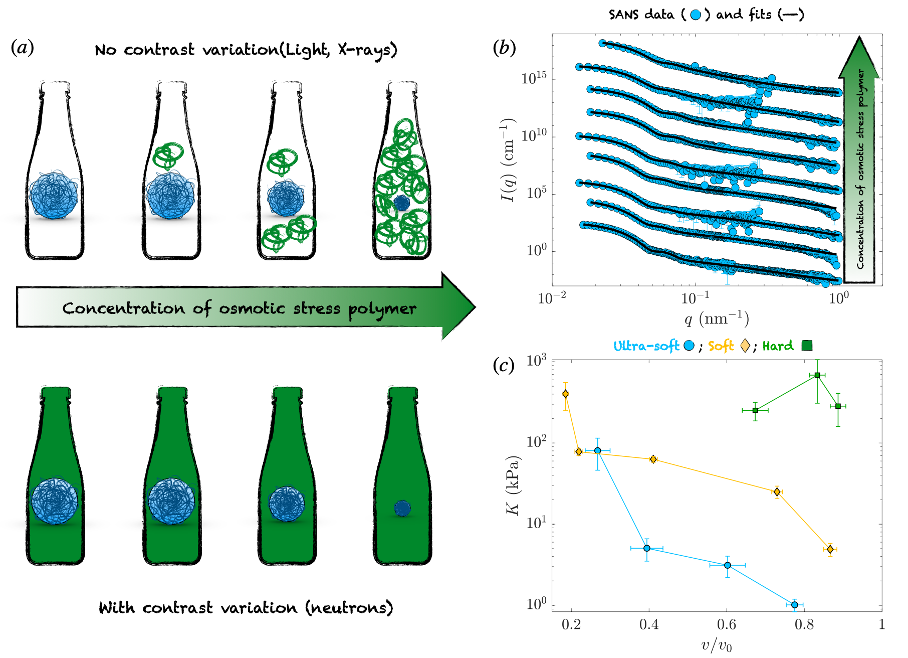Why?
An object's bulk modulus quantifies its resistance to an isotropic compression. For soft deformable colloids the bulk modulus must be known to predict their response to crowding.

Figure 1: (a) Sketch of the basic principle of our new method. Blue spheres represent the nanogels while the green lines are for the dPEG which, in neutrons, has the same contrast as the solvent (green). (b) Experimental SANS intensities I(q) vs scattering vector (q) for ultra-soft nanogels under increasing osmotic stresses (bottom to top). Solid lines are fits (c) Evolution of the particle bulk modulus with increasing compression, from right to left.
How?
An international research group has teamed up to develop a new approach to obtain partially-deuterated, high molecular weight, polyethylene glycol (dPEG), which is used to exert osmotic stress on soft objects with sizes of few hundreds of nanometers. In this study, nanogels – deformable crosslinked polymeric networks with sizes in the colloidal domain - were used as a model system for soft compressible spheres and their bulk modulus is determined by means of small-angle neutron scattering with contrast matching. By partial deuteration, the scattering length density of the dPEG was matched in pure heavy water (Fig. 1 (a)). Consequently, no contribution of the osmotic stress polymer is measured during the scattering experiments, and the form factor of the nanogels was directly measured as a function of the exerted osmotic stress, Fig 1(b). Fitting these data we obtain the values of the bulk modulus at different compression, Fig. 1(c). Furthermore, in addition to the total radius, the variation of the different characteristic lengths of the nanogels can be also measured. Therefore, using this method the different elasticity along a single particle, such as proteins or viruses, can be determined directly.
What´s next?
Now we aim to apply our method to study biologically-relevant macromolecules and colloids. We have applied for beamtime to use our methodology to probe the assembly and structure of virus capsids, and another to study the probe the structure of drug delivery vesicles, lipid nanoparticles, under external osmotic stress.
Who?
This work resulted from an international collaboration between an instrument scientist at the European Spallation Source (ESS, Sweden), Forschungszentrum Jülich (Germany), University of Barcelona (Spain), RWTH Aachen University (Germany), Institut Laue-Langevin (ILL, France), Paul Scherrer Institut, and (PSI, Switzerland). Funding was obtained by these universities, ILL, PSI and Deutsche Forschungsgemeinschaft (DFG – Germany).
Contact:
Dr Judith Houston
SANS Instrument Scientist
European Spallation Source ERIC
judith.houston@ess.eu
Dr Andrea Scotti
Junior Group Leader
RWTH Aachen University
scotti@pc.rwth-aachen.de
Cite: Adv Mater 2022, 34(26), e2200839
Cite: J. E. Houston, L. Fruhner, A. de la Cotte, J. Rojo González, A. Petrunin, U. Gasser, R. Schweins, J. Allgaier, W. Richtering, A. Fernandez-Nieves, and A. Scotti, Science Advances, 2022, 8, eabn6129
